Sleep consists of different stages, with REM and deep sleep being two of the most important. REM sleep includes dreaming and helps the brain process information, whereas deep sleep focuses on physical restoration and healing. Both stages are important for a healthy body and mind, though they serve very different purposes.
During REM sleep, the brain becomes active, and the eyes move rapidly. Deep sleep represents a much slower and quieter phase, during which the body undergoes repair. Understanding the difference between REM and deep sleep enables people to improve the quality of their rest and overall health.
Knowing how these two types of sleep function is key to developing better sleep habits. Recognizing their roles also explains why a full night’s sleep involves more than just the number of hours spent in bed.
Key Takeaways
- REM sleep supports brain function and memory.
- Deep sleep allows the body to repair and recover.
- Both stages prove essential to a healthy sleep cycle.
- A mattress that aligns the spine and relieves pressure points allows the body to enter deep sleep more easily.
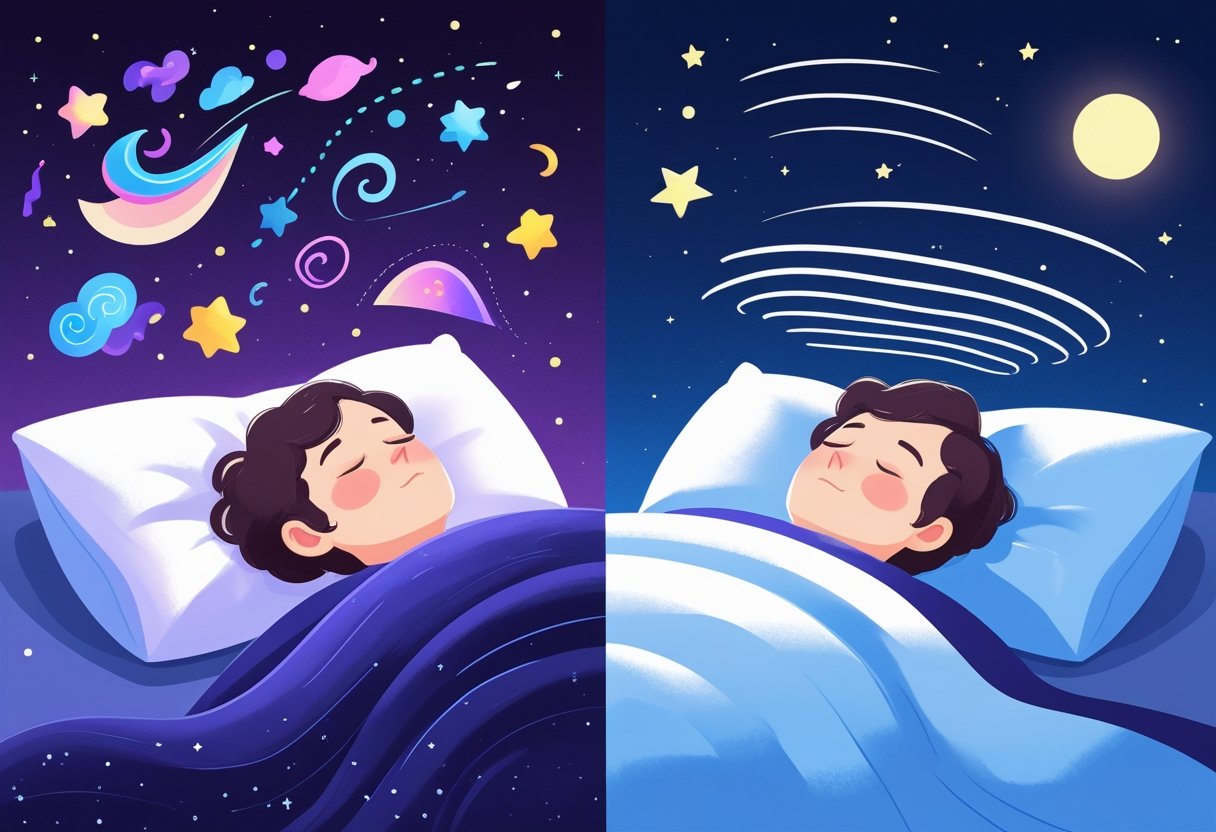
Understanding REM and Deep Sleep
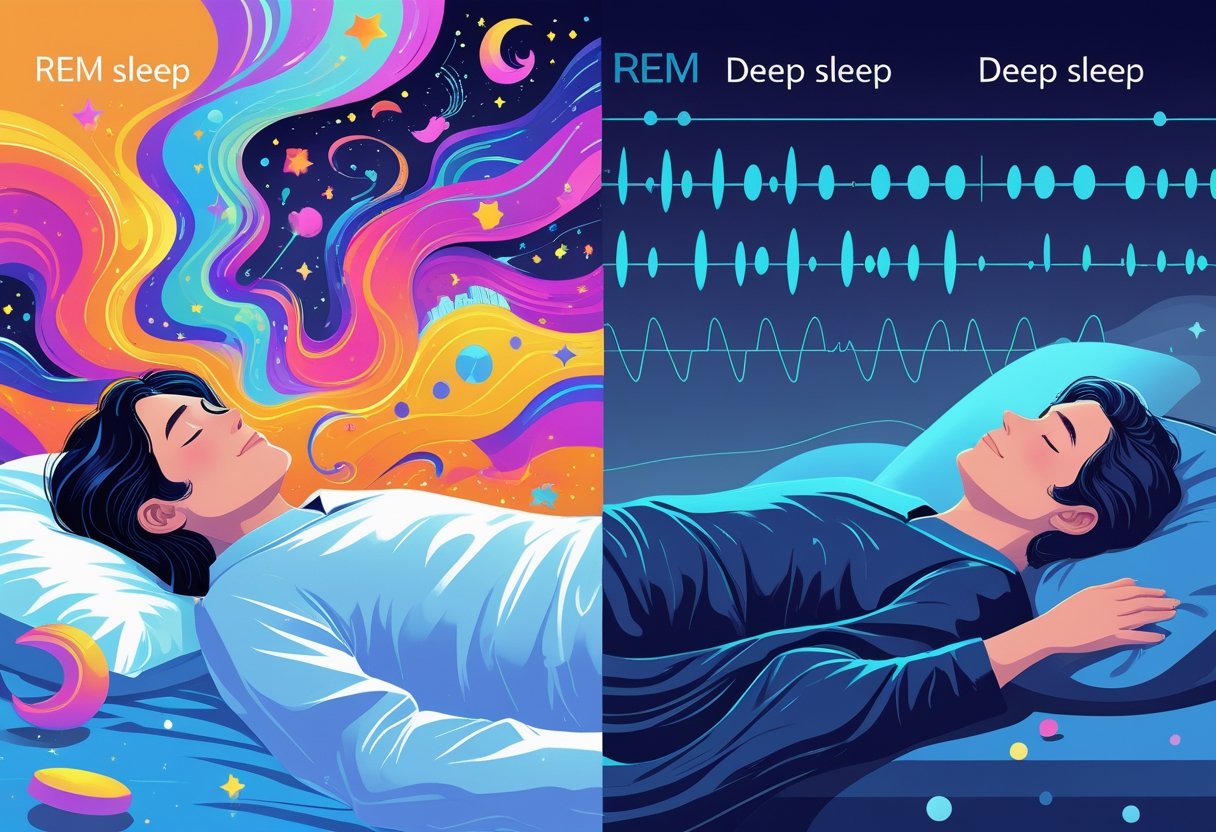
Sleep involves different phases that serve distinct functions for the body and brain. Some stages focus on rest and repair, while others engage brain activity such as dreaming. REM sleep and deep sleep a in this cycle but differ greatly in their characteristics and effects.
What Is REM Sleep
REM sleep stands for rapid eye movement sleep. During this stage, the eyes move quickly beneath closed eyelids. Most vivid dreaming occurs in this phase. Brain activity during REM sleep resembles the waking state, with fast and irregular brainwaves.
REM sleep supports memory and learning. It also influences mood and emotional well-being. The body’s muscles become mostly paralyzed during REM to prevent people from physically acting out their dreams. This phase usually follows deep sleep and repeats in cycles throughout the night.
What Is Deep Sleep
Deep sleep, also known as slow-wave sleep, belongs to non-REM sleep and focuses on physical rest and repair. Brainwaves slow significantly, making it difficult to wake someone during this phase. Deep sleep supports muscle growth and strengthens the immune system.
It acts as the most physically restorative stage. Blood pressure falls, breathing slows, and the body replenishes its energy. Deep sleep reduces fatigue and aids healing. Most core sleep benefits come from this phase, as it forms a vital part of the rest required for good health.
Stages of Sleep
- Stage 1 (Light Sleep):
Transition from wakefulness. This stage helps ease the process of falling asleep. - Stage 2 (Core Sleep):
Stable sleep with light brain activity. It supports memory and focus. - Stage 3 (Deep Sleep):
Slow-wave sleep, during which it becomes hard to wake someone up. This stage is important for physical rest and repair. - Stage 4 (REM Sleep):
Characterized by fast brain activity and dreaming. It’s important in mental restoration and memory processing.
Core sleep usually refers to stages 2 and 3 combined, with deep sleep being the deepest part of non-REM sleep. REM and deep sleep alternate throughout the night, each supporting physical and mental health in different ways.
Key Differences Between REM and Deep Sleep
REM and deep sleep are distinct stages in the sleep cycle with different roles. They differ in brain activity, bodily functions, and their impact on health. Understanding these differences clarifies why both stages remain important yet serve unique purposes.
Brain Activity and Physical Processes
During deep sleep, brain waves slow down significantly. This stage features slow, large brain waves called delta waves. Physical activity in the body reduces drastically such as muscle tone lowers, while heart rate and breathing slow.
In contrast, REM sleep exhibits brain activity resembling that of an awake state. The brain stays highly active, but muscles become nearly paralyzed to prevent acting out dreams. Eye movements occur rapidly, and breathing and heart rate may fluctuate irregularly.
This contrast shows that deep sleep provides the most physical rest, whereas REM sleep stands as the most mentally active phase.
Dreaming and Memory Consolidation
Dreaming occurs primarily during REM sleep. This stage is important in processing emotions and forming memories, particularly those connected to learning and creativity. Dreaming appears rarely or minimally in deep sleep. Instead, this stage supports consolidating factual memories and clearing metabolic waste from the brain.
REM sleep assists in linking new memories to existing ones, while deep sleep strengthens the retention of facts and events from the day. Together, these stages collaborate to maintain healthy brain function.
Physical Restoration and Immune Function
Deep sleep represents the key phase for physical healing. The body releases growth hormones that promote repair of muscles, tissues, and bones. Immune system activity increases during this time, enhancing resistance against illness. Although REM sleep contributes less directly to physical repair, it plays a vital role in regulating mood and stress, factors that influence overall health.
While REM sleep often associates with mental restoration, deep sleep provides the deepest physical rest and recovery. This distinction highlights how the body’s healing processes rely on both stages in different ways.
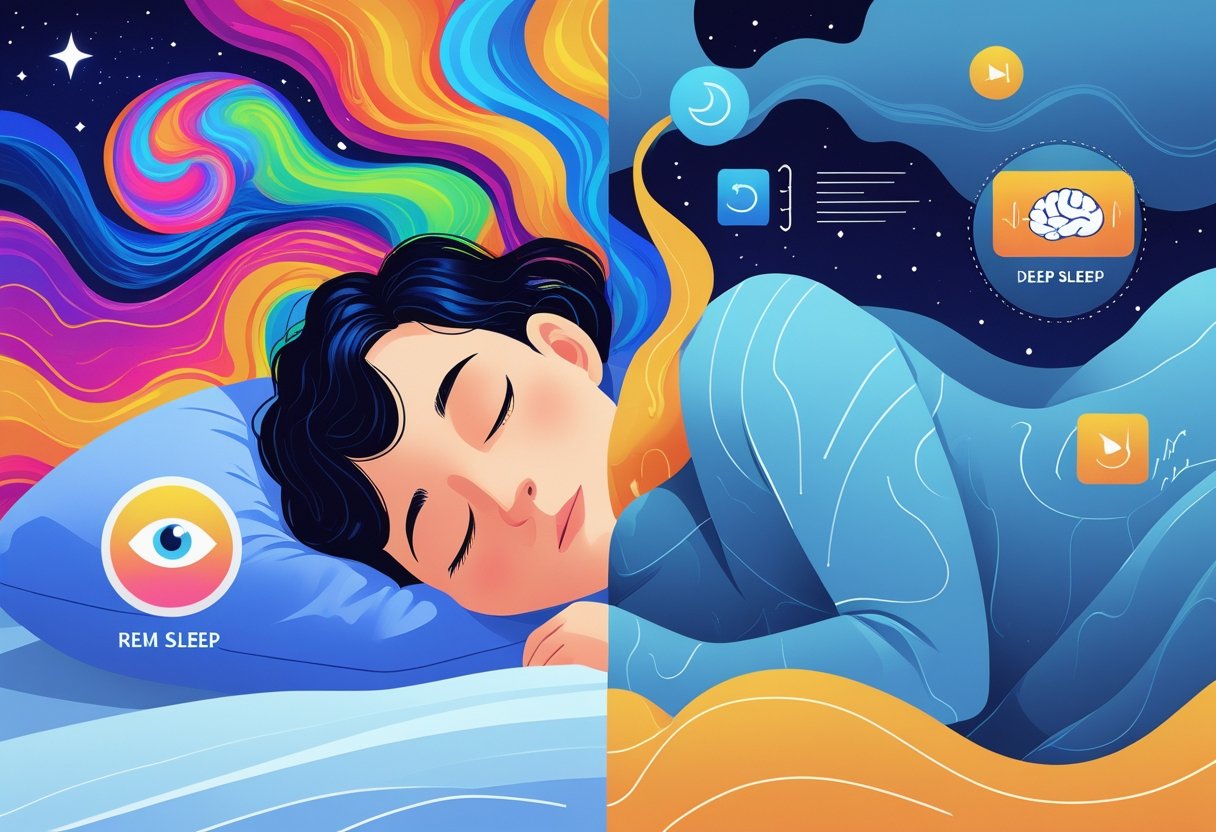
How REM and Deep Sleep Fit Into Your Sleep Cycle
REM and deep sleep are key stages that occur repeatedly during the night, each serving distinct roles. Their timing and order follow a predictable pattern, which influences how rested someone feels by morning.
Sleep Architecture and Cycles
Sleep cycles usually last about 90 to 110 minutes and include multiple stages. These stages divide into non-REM (NREM) sleep, which includes deep sleep, and REM sleep.
Deep sleep happens during the third stage of NREM sleep, often called slow-wave or core sleep. It represents the most restorative part of sleep, essential for physical repair and memory consolidation. REM sleep follows the NREM stages and marks the time when most dreaming occurs. It supports emotional health and brain function.
An adult’s sleep cycle includes two main stages relevant here: deep sleep and REM sleep. Deep sleep, responsible for body repair and characterized by slow brain waves, typically lasts between 20 and 40 minutes per cycle. REM sleep, marked by dreaming and increased brain activity, usually lasts from 10 to 30 minutes per cycle.
Timing and Sequence
After falling asleep, it usually takes about 45 to 90 minutes to enter deep sleep for the first time. This range varies depending on the individual and factors such as age or sleep quality.
Deep sleep dominates the first half of the night. As cycles repeat, it becomes harder to fall back into deep sleep quickly. REM sleep appears first in short bursts around 70 to 90 minutes after sleep onset. These REM periods become longer and more frequent closer to waking. Since REM lengthens through the night, the second half of sleep contains more REM than deep sleep.
Understanding this timing explains why disruptions early in the night tend to affect deep sleep, while waking later reduces REM sleep. This balance shapes overall sleep quality and daytime function.

REM Sleep vs Deep Sleep: Importance for Health
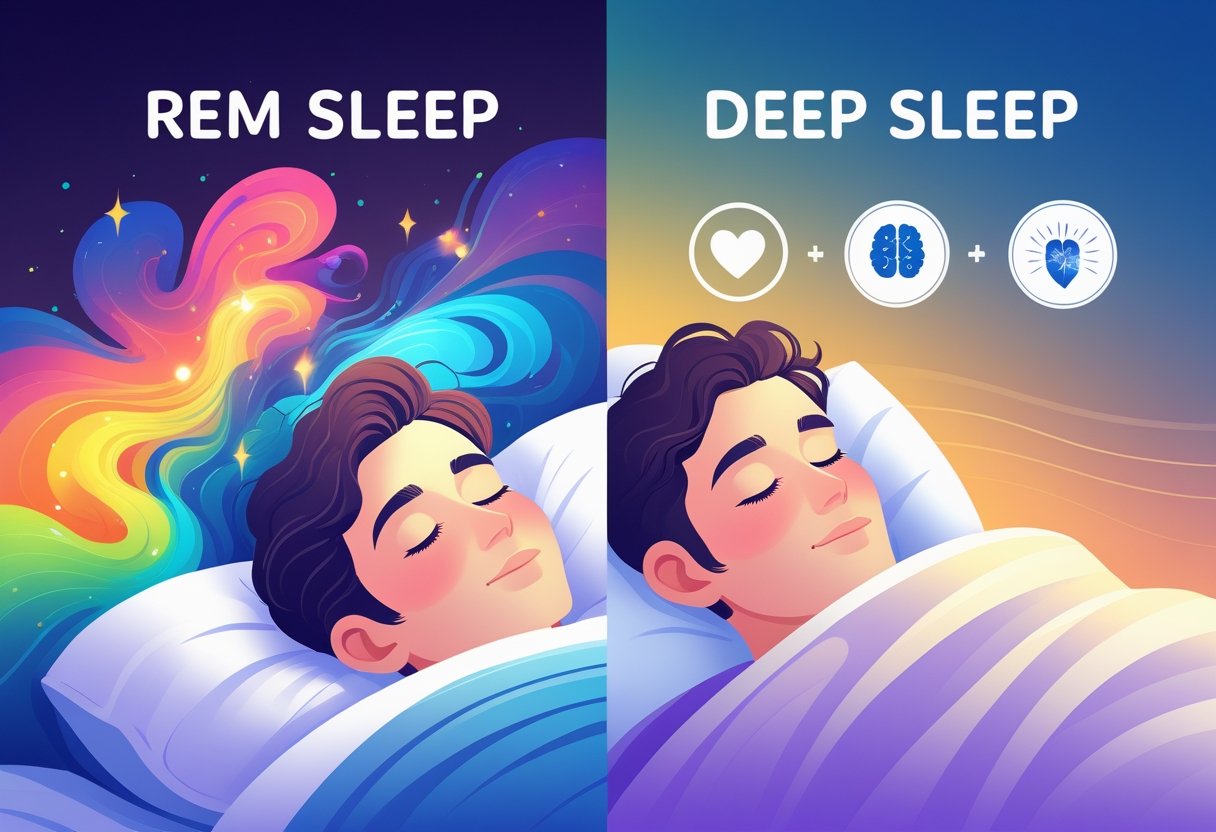
REM sleep and deep sleep have different but equally vital functions for both the mind and body. Each type supports distinct health needs, which makes it essential to maintain a balance between the two within a healthy sleep cycle.
Roles in Cognitive and Physical Health
REM sleep primarily supports brain functions such as memory, learning, and emotional balance. During this stage, the brain processes information and strengthens neural connections. It is also important in regulating mood and managing stress.
Deep sleep concentrates on physical repair and growth. This stage encourages tissue healing, muscle recovery, and boosts the immune system. It further supports hormone regulation that influences growth and metabolism.
Neither stage holds greater importance, as they fulfill different purposes. Achieving balance matters: REM sleep enhances cognitive health, while deep sleep remains crucial for physical restoration.
Sleep Disorders Related to REM and Deep Sleep
Certain sleep disorders stem from disruptions in either REM or deep sleep. REM sleep disorders include REM sleep behavior disorder, which causes people to act out their dreams, potentially affecting emotional health and safety. Disruptions in deep sleep can impair physical recovery and weaken immune function. Conditions such as sleep apnea often reduce deep sleep, resulting in daytime fatigue and slower healing.
Identifying which sleep stage suffers damage helps in diagnosing and treating these disorders, underscoring why both REM and deep sleep remain essential for overall well-being.
REM, Core, and Deep Sleep
Sleep consists of different stages, each serving distinct roles in physical and mental recovery. REM, core, and deep sleep influence the brain and body in unique ways, although some functions overlap.
Definitions and Overlapping Features
REM sleep, or rapid eye movement sleep, relates mainly to brain activities such as dreaming, memory, and learning. During REM, brain waves become fast and irregular, resembling those experienced while awake.
Core sleep refers to the lighter stages of non-REM sleep. It acts as a transition between deep and REM sleep and contributes to overall rest. Core sleep accounts for a large portion of total sleep time and helps restore cognitive and physical functions.
Deep sleep represents the deepest phase of non-REM sleep. It features slow delta brain waves and is important in muscle repair, immune function, and physical restoration. Whereas REM focuses on brain processes, deep sleep prioritizes body recovery.
Although these stages share some overlap, each fulfills a specific function crucial to health.
Practical Implications
Understanding the differences between REM, core, and deep sleep allows better focus on improving sleep habits. For instance:
- Deep sleep increases following physical exertion to aid muscle recovery.
- REM sleep supports learning, emotional health, and memory consolidation.
- Core sleep ensures steady, balanced rest throughout the night.
Products like mattresses and sleep apps often target these stages differently according to their benefits. Factors such as stress, diet, and exercise influence the time spent in each stage.
Balancing all three proves essential for overall health, since good sleep depends not only on total hours but also on the quality of each sleep stage.
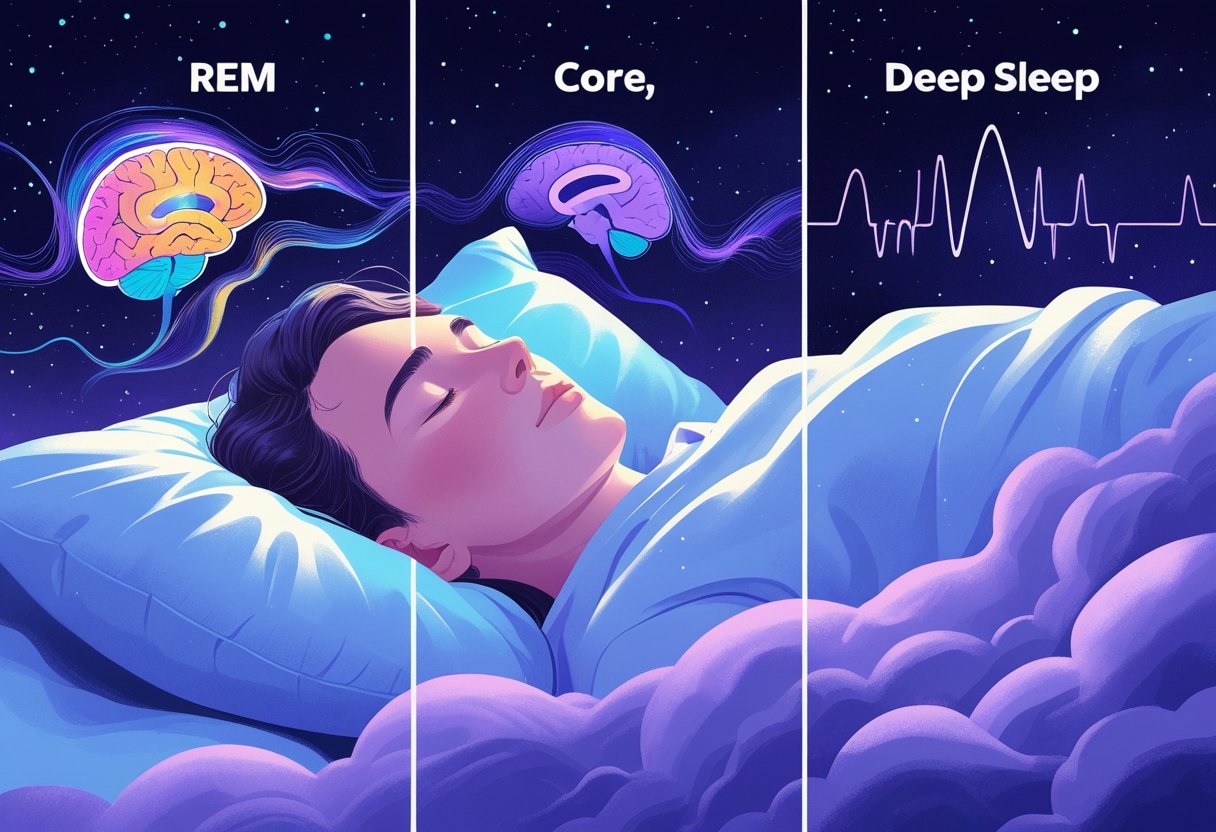
Common Myths About REM and Deep Sleep
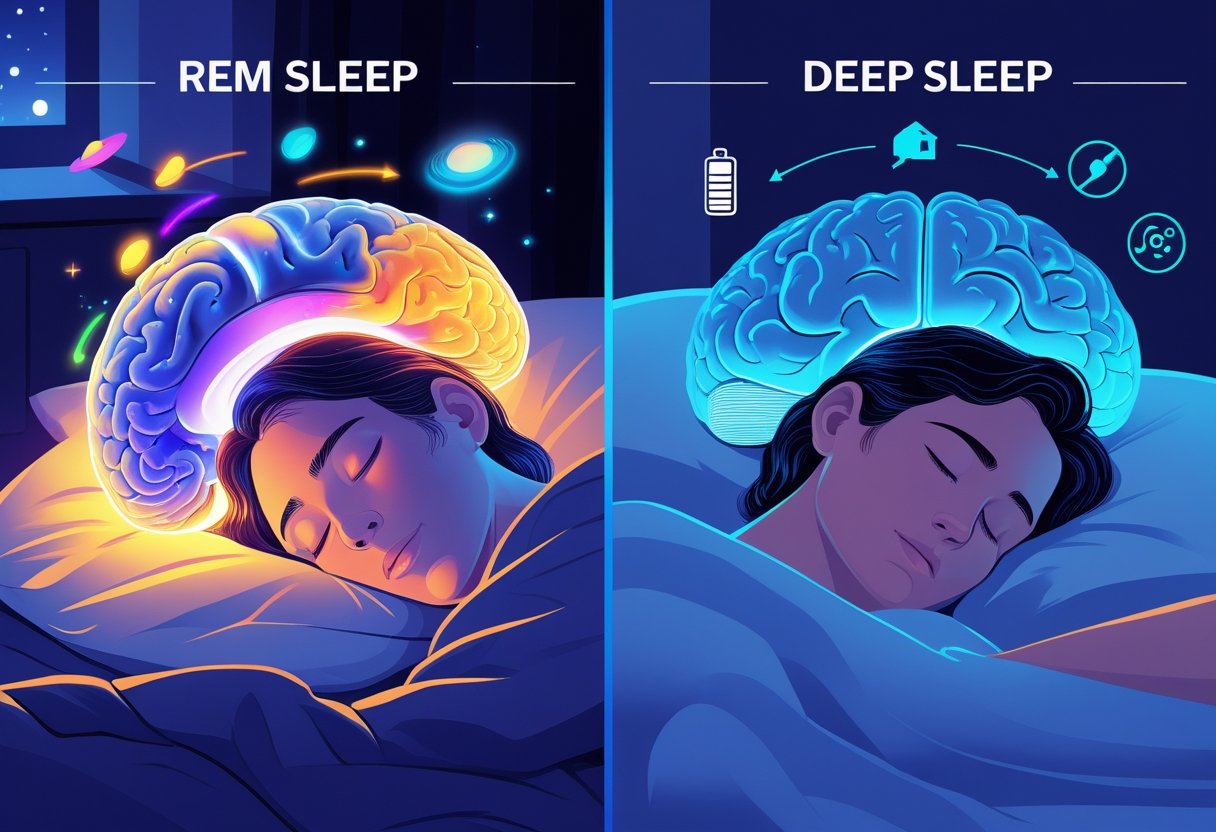
REM and deep sleep are two separate stages of the sleep cycle, each with its own role. Many confuse the two or wonder when dreaming takes place. Knowing what each stage does helps clear up common misconceptions.
Is REM Sleep the Same as Deep Sleep?
REM sleep and deep sleep are not the same. REM stands for Rapid Eye Movement, a stage marked by intense brain activity and vivid dreams. Deep sleep, also known as slow-wave sleep, belongs to the non-REM category and features very slow brain waves.
Deep sleep supports physical recovery, including muscle repair and immune system function. Growth hormone releases primarily during this stage. In contrast, REM sleep plays an important role in memory consolidation, learning, and emotional regulation.
During REM sleep, brain activity rises to levels close to wakefulness, while the body remains still due to muscle atonia. Deep sleep, by contrast, features slow delta brain waves and allows the body to focus on tissue growth and cell repair. Dreaming occurs most vividly and frequently in REM sleep. In deep sleep, dreams rarely occur since the brain enters a much quieter state.
Do You Dream in Deep Sleep?
Most dreaming takes place during REM sleep. This phase produces vivid, narrative-like dreams due to heightened brain activity. Deep sleep, by contrast, involves minimal brain activity connected to dreaming. While some fleeting thoughts or mental images might surface during deep sleep, fully developed dreams are rare. This stage prioritizes physical recovery more than mental processing.
Some believe deep sleep is completely dreamless, which holds true for the most part. The mind stays mostly quiet while the body focuses on restoration. That’s why REM sleep often links to emotional and cognitive function, whereas deep sleep supports physical well-being.
How Your Mattress Affects REM and Deep Sleep Quality
A good mattress matters for better sleep. It supports your body and takes pressure off certain areas so you can rest without pain. If a mattress is too hard or too soft, it can be uncomfortable. This often makes you toss and turn or wake up in the middle of the night. When sleep keeps getting interrupted, both deep sleep and REM sleep suffer.
A well-made mattress keeps your body in the right position. It helps your muscles relax so your whole body can rest. Deep sleep starts when you’re fully relaxed and your body begins to repair itself. In REM sleep, your brain is active. If you’re comfortable, you’re less likely to wake up or fall into light sleep too soon.
Choosing a mattress made with breathable and adaptive materials can also improve sleep. Some hybrid models, like the Helix Midnight Luxe, combine memory foam with zoned lumbar support to boost both comfort and alignment. Research on sleep stages shows that the right mattress may increase time spent in REM and deep sleep by 20% to 60%.
The Helix Midnight Luxe suits side and back sleepers who need pressure relief around the shoulders and hips without losing proper support. It includes a plush pillow top, a breathable cooling cover, and zoned coils that cushion the body while keeping the spine aligned, all working together to promote deeper and more restorative sleep.
Key mattress features that improve REM and deep sleep:
- Proper support for spinal alignment
- Pressure relief for hips and shoulders
- Breathable materials to stay cool
- Long-term durability to preserve support
Better sleep starts with the right mattress. It helps sharpen memory, boost energy, and support overall health, and often becomes the first step to improving deep and REM sleep quality.

Frequently Asked Questions
REM sleep and deep sleep serve different functions, yet both are crucial for overall health. Their timing, duration, and benefits differ depending on factors like age, stress, and daily habits.







